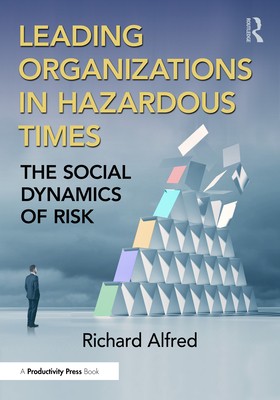
- We will send in 10–14 business days.
- Author: Richard Alfred
- Publisher: Productivity Press
- ISBN-10: 1032371692
- ISBN-13: 9781032371696
- Format: 17.8 x 25.4 x 1.4 cm, minkšti viršeliai
- Language: English
- SAVE -10% with code: EXTRA
Reviews
Description
As leaders across industries are aware, risk has become one of the defining features of modern society. We come face to face with danger and calls for vigilance on an almost daily basis. Natural calamities such as earthquakes and hurricanes cause great damage and upend lives. Human-caused disasters like climate change wreak havoc on worldwide enterprise because of global interdependencies. Technological breakthroughs such as automation and artificial intelligence change life and work by overturning established business models. The onset of catastrophe is destructive in its own right, but it is only part of the problem. Amplifying its impact is human behavior which shapes assessment and response to risk.
As people come up against the harsh realities of danger, a natural response is to do nothing, to flee, or to fight. Some are overcome by fear and become immobile. Others move into action--rather than freezing, they act quickly and decisively. And still others ignore the possibility of harm--avoidance and denial are used to eliminate the specter of danger. Risk is an ubiquitous part of life in modern society--a dynamic deeply intertwined with human behavior. The first step in managing it is for organizations to achieve a better understanding of human behavior.
The aim of The Social Dynamics of Risk: What Organizations Must Do to Manage Modern Risk is to help organizations and leaders more effectively manage risk by understanding how behavior and attitudes unfold as a function of four factors: 1) societal conditions, 2) patterns of social interaction, 3) organizational purpose and behavior, and 4) the human nervous system. Each of these factors has been shown to have a significant influence on attitudes and behavior. Less well understood, however, is the way in which they interact to shape assessment and response to risk and what organizations can do to more effectively manage risk.
This book is the first of its kind to comprehensively examine organizational and human behavior in relationship to risk through the broad lens of the social sciences including neuroscience. Its aim is to help organizations and leaders more effectively manage risk by unbundling the factors shaping risk perception and behavior and transforming risk from threat to opportunity. The author employ a cross-disciplinary approach to prepare organizations for management of modern risk - a form of risk uniquely at work in advanced societies.
EXTRA 10 % discount with code: EXTRA
The promotion ends in 23d.16:30:45
The discount code is valid when purchasing from 10 €. Discounts do not stack.
- Author: Richard Alfred
- Publisher: Productivity Press
- ISBN-10: 1032371692
- ISBN-13: 9781032371696
- Format: 17.8 x 25.4 x 1.4 cm, minkšti viršeliai
- Language: English English
As leaders across industries are aware, risk has become one of the defining features of modern society. We come face to face with danger and calls for vigilance on an almost daily basis. Natural calamities such as earthquakes and hurricanes cause great damage and upend lives. Human-caused disasters like climate change wreak havoc on worldwide enterprise because of global interdependencies. Technological breakthroughs such as automation and artificial intelligence change life and work by overturning established business models. The onset of catastrophe is destructive in its own right, but it is only part of the problem. Amplifying its impact is human behavior which shapes assessment and response to risk.
As people come up against the harsh realities of danger, a natural response is to do nothing, to flee, or to fight. Some are overcome by fear and become immobile. Others move into action--rather than freezing, they act quickly and decisively. And still others ignore the possibility of harm--avoidance and denial are used to eliminate the specter of danger. Risk is an ubiquitous part of life in modern society--a dynamic deeply intertwined with human behavior. The first step in managing it is for organizations to achieve a better understanding of human behavior.
The aim of The Social Dynamics of Risk: What Organizations Must Do to Manage Modern Risk is to help organizations and leaders more effectively manage risk by understanding how behavior and attitudes unfold as a function of four factors: 1) societal conditions, 2) patterns of social interaction, 3) organizational purpose and behavior, and 4) the human nervous system. Each of these factors has been shown to have a significant influence on attitudes and behavior. Less well understood, however, is the way in which they interact to shape assessment and response to risk and what organizations can do to more effectively manage risk.
This book is the first of its kind to comprehensively examine organizational and human behavior in relationship to risk through the broad lens of the social sciences including neuroscience. Its aim is to help organizations and leaders more effectively manage risk by unbundling the factors shaping risk perception and behavior and transforming risk from threat to opportunity. The author employ a cross-disciplinary approach to prepare organizations for management of modern risk - a form of risk uniquely at work in advanced societies.


Reviews